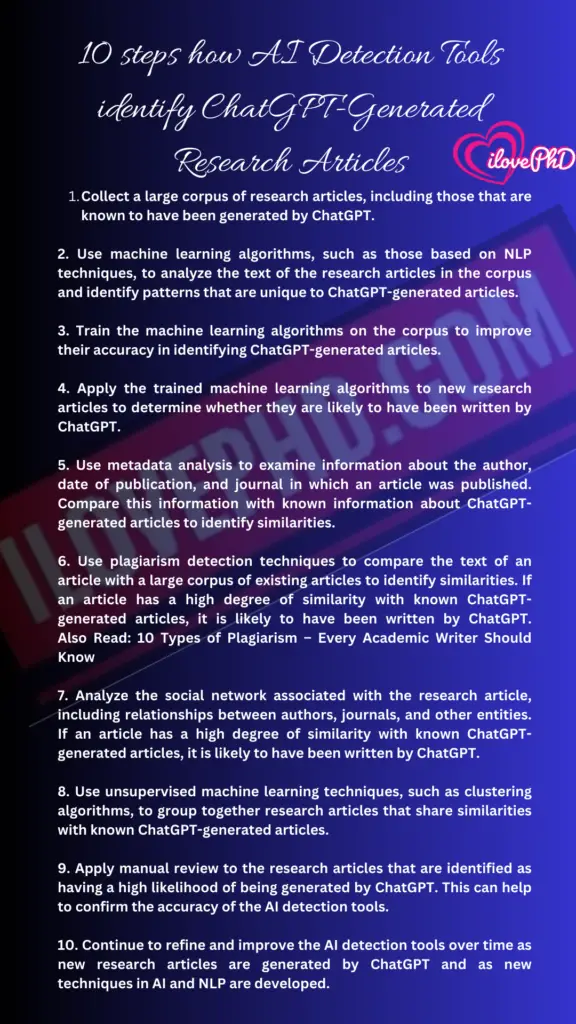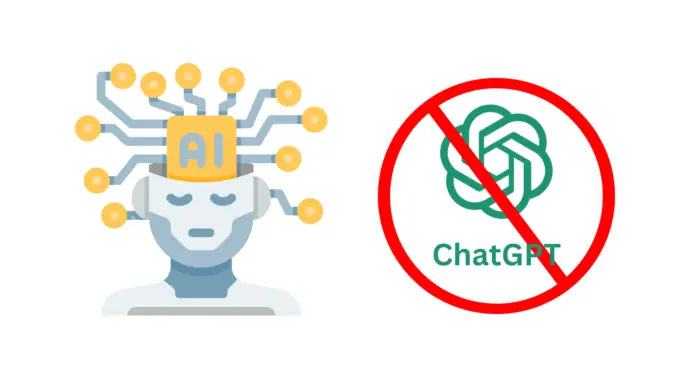Artificial intelligence (AI) detection tools have become increasingly popular for detecting research articles written by ChatGPT. ChatGPT is a large language model developed by OpenAI that is capable of generating human-like responses to text inputs.
It has been widely used in various applications such as chatbots, language translation, and content generation. However, the authenticity of research articles generated by ChatGPT has been a concern among scholars and researchers.
In this article iloevphd listed the 10 steps of how AI Detection Tools detect ChatGPT-Generated Research Articles.
AI Detection Tools for ChatGPT-Generated Research Articles
AI detection tools use various techniques to identify research articles written by ChatGPT. One of the most popular methods is based on machine learning algorithms that are trained on a large corpus of research articles.
Natural language processing techniques for ChatGPT detection
These algorithms use natural language processing (NLP) techniques to analyze the text and identify patterns that are unique to research articles. The algorithms then apply these patterns to new articles to determine whether they are likely to have been written by ChatGPT.
AI detection tools for identifying ChatGPT-generated articles
Another method used by AI detection tools is based on the analysis of metadata associated with research articles. Metadata refers to information about the article such as the author’s name, date of publication, and the journal in which it was published.
AI detection tools can compare this metadata with known information about ChatGPT-generated articles to determine whether an article is likely to have been written by ChatGPT.
Plagiarism detection for ChatGPT-generated research
AI detection tools also use plagiarism detection techniques to identify research articles written by ChatGPT. Plagiarism detection tools compare the text of an article with a large corpus of existing articles to identify similarities.
If an article has a high degree of similarity with known ChatGPT-generated articles, it is likely to have been written by ChatGPT.
10 Steps for Detecting Research Articles Written by ChatGPT using AI Detection Tools
- Collect a large corpus of research articles, including those that are known to have been generated by ChatGPT.
- Use machine learning algorithms, such as those based on NLP techniques, to analyze the text of the research articles in the corpus and identify patterns that are unique to ChatGPT-generated articles.
- Train the machine learning algorithms on the corpus to improve their accuracy in identifying ChatGPT-generated articles.
- Apply the trained machine learning algorithms to new research articles to determine whether they are likely to have been written by ChatGPT.
- Use metadata analysis to examine information about the author, date of publication, and journal in which an article was published. Compare this information with known information about ChatGPT-generated articles to identify similarities.
- Use plagiarism detection techniques to compare the text of an article with a large corpus of existing articles to identify similarities. If an article has a high degree of similarity with known ChatGPT-generated articles, it is likely to have been written by ChatGPT. Also Read: 10 Types of Plagiarism – Every Academic Writer Should Know
- Analyze the social network associated with the research article, including relationships between authors, journals, and other entities. If an article has a high degree of similarity with known ChatGPT-generated articles, it is likely to have been written by ChatGPT.
- Use unsupervised machine learning techniques, such as clustering algorithms, to group together research articles that share similarities with known ChatGPT-generated articles.
- Apply manual review to the research articles that are identified as having a high likelihood of being generated by ChatGPT. This can help to confirm the accuracy of the AI detection tools.
- Continue to refine and improve the AI detection tools over time as new research articles are generated by ChatGPT and as new techniques in AI and NLP are developed.
In addition to these methods, AI detection tools may also use social network analysis to identify research articles written by ChatGPT.
Social network analysis for ChatGPT detection
Social network analysis involves analyzing the relationships between authors, journals, and other entities associated with research articles. If an article has a high degree of similarity with known ChatGPT-generated articles, it is likely to have been written by ChatGPT.
4 Popular AI detection tools to detect ChatGPT-generated research articles
A few popular AI detection tools that are commonly used for identifying research articles written by ChatGPT are listed:
1. Turnitin
Turnitin is a well-known plagiarism detection tool that can identify text that matches with known ChatGPT-generated articles.
2. iThenticate
iThenticate is another popular plagiarism detection tool that can compare research articles with a large corpus of existing articles to identify similarities.
3. Grammarly
Grammarly is an AI-based writing assistant that can identify patterns and writing styles that are unique to ChatGPT-generated articles.
4. Copyscape
Copyscape is a plagiarism detection tool that can compare the text of an article with a large corpus of existing articles to identify similarities with known ChatGPT-generated articles.
These are just a few examples of AI detection tools that can be used to identify research articles written by ChatGPT.
Summary
AI detection tools are essential for identifying research articles written by ChatGPT. These tools use a variety of techniques such as machine learning algorithms, metadata analysis, plagiarism detection, and social network analysis to identify patterns and similarities that are unique to ChatGPT-generated articles.
As the use of ChatGPT continues to grow, the importance of AI detection tools will only increase in the detection of ChatGPT-generated research articles.
I hope this article would help you to know about the importance of Detecting ChatGPT-Generated Research Articles using online AI Detection Tools.



